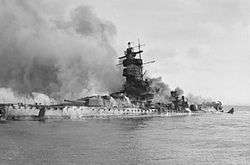1943 Argentine coup d'état
|
A newspaper announcing the beginning of the coup. | |
| Date | June 4, 1943 |
|---|---|
| Location | Argentina |
| Also known as | Revolution of '43 |
| Outcome | End of Ramón Castillo's presidency. |
The 1943 Argentine coup d'état, also known as the Revolution of '43, was a coup d'état on June 4, 1943, which ended the government of Ramón Castillo, who had been fraudulently elected to office[1] of vice-president, as part of the period known as the Infamous Decade. The military was opposed to Governor Robustiano Patrón Costas, Castillo's hand-picked successor, the principal landowner in Salta Province, as well as a main stockholder in the sugar industry. The only serious resistance to the military coup came from the Argentine Navy, which confronted the advancing army columns at the Navy's School of Mechanics.
Coup
The heads of state of Argentina during this time period were Arturo Rawson, Pedro Pablo Ramírez and Edelmiro Farrell. During this period, the internal disputes in Argentina about the stance towards World War II, where society and politicians were torn between staying neutral and safely providing foodstuffs to the Allies, or joining the allied side. Ramírez suspended relations with the Axis Powers on January 1944, and Farrell entered the War on March 1945, at a time when the war was mostly decided.
The government also saw the rise of Colonel Juan Domingo Perón, a member of the United Officers' Group (GOU), who would become one of the most influential politicians in Argentine history. Perón worked as an assistant to Secretary of War General Edelmiro Farrell during Ramírez' time in office, and then as the head of a mostly insignificant Department of Labour. From that position, he endorsed and enforced a set of labour laws that gained him high popular prestige, especially among the working classes, and the alliance of the socialist and syndicalist labor unions, thus levering his position inside the military government. When Farrell succeeded Ramírez, Perón was designated Vice-President and Secretary of War, and retained the labor portfolio, which was promoted to Ministry. As Minister of Labor, Perón settled industrial disputes in favour of labour unions and introduced a wide range of social welfare benefits for unionized workers.[2] Leveraging his authority on behalf of striking abattoir workers and the right to unionize, he became increasingly thought of as having presidential timber.
As he faced a growing opposition within the armed forces, Perón was forced to resign on October 9, 1945, and arrested four days later, but mass demonstrations organized by the General Confederation of Labour forced his release on October 17, a day later remembered as Loyalty Day by the Peronist movement. Upon his release, Farrell pledged to step down and call for elections. Juan Perón became President after winning a landslide on the February 1946 elections.
See also
References
- ↑ Rock, David. Authoritarian Argentina. University of California Press, 1993.
- ↑ The Penguin History of Latin America by Edwin Williamson

